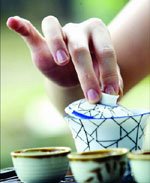I visited the Flagstaff House Museum of Teaware on June 18. I made a special trip to Hong Kong just to go see it. And I have always wanted to see what a tea museum would be like. Ok, maybe you're thinking – “teaware museum, cool!” That's what I always thought. But it wasn't all that exciting. The whole event was anticlimactic and uneventful. There was nothing there that was really awe-inspiring.
There is some old teaware on display, or modern reproductions of ancient teaware. And the walls have displays and photos of tea preparation through the ages – written both in Chinese and English. Let me give you a tip: if you plan a trip to this museum, be sure to bring a Chinese friend along who can translate the Chinese for you. Some of the explanations in Chinese are not the same in English. There's information missing in the English translations – not that it's really important. But if you want to be accurate, then, it's helpful to have a friend along who can translate.
The lower floor has displays of ancient Chinese teaware, and a gift shop selling well, teaware, tea, and books and DVDs. The books themselves are worth a trip to the museum. It's hard to find books like these translated into English. But these ones looked pretty good. They also had some DVDs available about Chinese tea culture. But I'm not sure if they have an English track to them or not.
While I was in the museum, they showed a DVD about tea processing of Anxi Tieguanyin. But it was all in Cantonese – which, hey, is ok if you can speak Cantonese (like me). But if you can't understand, then, you really miss out on the information they present. That's why it's helpful to have a friend along who can translate.
Then, the upper floor has more display rooms, currently showing modern pieces by contemporary Hong Kong potters. But I didn't think it was really that good. It was very artsy, and a lot of the pieces looked impractical to use. They just seemed to be a collection of lots of clunky, large tea pots, and tea cups. Considering China has thousands of years of tea history, and thousands of years of teaware development, these new pieces seem unrefined, and just not in flow with the past. In short, they looked like pieces not to be used, but to be put on display. Anyway, I didn't get it. But, they did have video displays in English to discuss the pottery art, and they also did try to educate visitors about various pottery processes used to create the pieces. So maybe that is a plus.
Their display on gongfu tea didn't seem to be well-researched. Well, let's be honest here. It's not well researched. It's just a very over-simplified description. And the information they present on the origin of gongfu tea is misleading. But go to the museum and see for yourself.
To sum up, I thought I would be steeped in the tea experience. But nothing special really happened. The whole trip was kind of a bummer – until... until I got to Shenzhen and went back to Tea World. At Tea World, I bumped into some Chaozhou people, and they brewed up Fenghuang Dancong 凤凰单枞 for me. They didn't do it in the traditional Chaozhou style of gongfu tea. But they used a gaiwan method, so I could taste the true nature of the tea; and appreciate the qi of the tea. Well, they boiled 1 kettle full of water and brewed the tea from that single gaiwan of Dancong tea. Then, they boiled a second kettle of water for that same gaiwan of Dancong. I continued drinking. They boiled a third kettle of water for the same gaiwan of Dancong. I drank steep after steep after steep of the same infusion of leaf. I wasn't counting, but it must have been over 20 infusions. They were about to boil a fourth kettle of water and continue brewing the same gaiwan. But I stopped at the end of the third kettle – because A. I had to go to the washroom; and B. I got smashingly tea drunk (although I had just eaten a heavy meal of McDonald's which is right next door to Tea World). I have to say, I have never gotten tea drunk like this before in my life. It was almost a narcotic-like experience (maybe – I don't actually know what narcotics are like). But it sure felt strange – although I was still fully mentally aware. But then after that, it was much easier for other vendors to sell me their teas. I bought a bag of that Dancong for my friends to try. Maybe they will get as tea drunk as I did. And I also I bought 2 sheng puer cakes from Ban Zhang factory. I have to admit, my puer collection is pretty shameful. So I need to grow my own personal inventory.
The verdict: If you want a really good tea experience, after your trip to HK, cross the border into Shenzhen, and experience the world of tea.
Immortal's Palm Tea
-
by STEVEN D. OWYOUNG
AUTHOR'S NOTE: *This essay is dedicated to Frank Hadley Murphy, author of
The Spirit of Tea, for his kind introduction to the poet Li B...
14 years ago


No comments:
Post a Comment